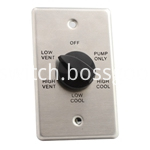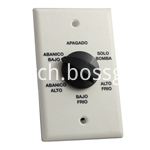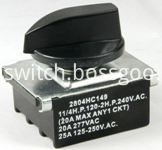The original power supply has various forms, but no matter which kind of power supply, it is generally not possible to directly supply power to the LED. Therefore, to use LED as the illumination source, we must first solve the power conversion problem. The LED is actually a current-driven low-voltage unidirectional conductive device. The LED driver should have DC control, high efficiency, PWM dimming, overvoltage protection, load disconnection, small size, and ease of use. The following must be observed when designing a power converter that supplies power to the LED.
1 Since the LED is a unidirectional conductive device, the LED should be powered by a direct current or a unidirectional pulse current.
2 Since the LED is a semiconductor device with a PN junction structure and has a barrier electromotive force, this forms a turn-on threshold voltage, so the voltage applied to the LED must exceed this threshold voltage, and the LED is fully turned on. The threshold voltage of high-power LEDs is generally above 2.5V, and the voltage drop of LEDs during normal operation is 3~4V.
The current and voltage characteristics of the 3LED are non-linear. Because the current flowing through the LED is numerically equal to the electromotive force of the power supply minus the potential of the LED, and then divided by the total resistance of the circuit (the sum of the internal resistance of the power supply, the lead resistance, and the resistance of the LED body), the current flowing through the LED It is not proportional to the voltage applied across the LED.
4 Since the PN junction of the LED has a negative temperature coefficient, the barrier electromotive force of the LED will decrease when the temperature rises. Therefore, the LED cannot be directly powered by the voltage source, and current limiting measures must be taken. Otherwise, as the temperature of the LED increases, the current will become larger and larger, causing damage to the LED.
5 The ratio of the current flowing through the LED to the luminous flux of the LED is also non-linear. The luminous flux of an LED increases as the current flowing through the LED increases, but it is not proportional, and the later the luminous flux increases. Therefore, the LED should be operated at a current value with a relatively high luminous efficiency.
In addition, LEDs, like other light sources, can withstand limited electrical power. If the electric power applied to the LED exceeds a certain value, the LED may be damaged. Due to differences in production process and material properties, the barrier electromotive force of the same type of LED and the internal resistance of the LED are not exactly the same, which leads to inconsistent voltage drop during LED operation, and the LED barrier electromotive force has a negative temperature coefficient. Therefore, LEDs cannot be used in parallel directly.
There are four cases for powering the LED with the original power supply: low voltage drive, transient voltage drive, high voltage drive, and mains drive. Different situations have different solutions for the implementation of power converter technology. The following briefly describes the methods of driving the LEDs by the above several types of power sources. 1. Low voltage drive LED
Low-voltage driving means driving the LED with a voltage lower than the forward voltage drop of the LED. For example, an ordinary dry battery or a nickel-chromium/nickel-hydrogen battery is used to drive the LED. The normal supply voltage is between 0.8 and 1.65V. When driving LEDs with low voltage, the voltage needs to be raised enough to turn on the LEDs. For low-power lighting devices such as LEDs, low-voltage driving is a common use case, such as LED flashlights and LED emergency lights. , energy-saving lamps and so on. Due to the limitation of single-cell battery capacity, low-voltage driving power supplies generally do not require a lot of power, but require the lowest cost and relatively high conversion efficiency. Considering that it is sometimes necessary to work with a No. 5 battery, it is necessary to It has the smallest volume. The best technical solution is to use a capacitive boost converter.
2. Transition voltage drive LED
The transition voltage drive means that the voltage value of the power supply to the LED varies around the LED voltage drop. This voltage may sometimes be slightly higher than the voltage drop of the LED, and may sometimes be slightly lower than the voltage drop of the LED. For example, a power supply consisting of a lithium battery or two series-connected lead-acid batteries, when the battery is fully charged, its voltage is above 4V, and when the battery is discharged, the voltage is below 3V. The typical application is LED miner's lamp.
The power conversion circuit of the transition voltage driving LED not only solves the boosting problem, but also solves the step-down problem. In order to work with a lithium battery, it is also required to have the smallest possible volume and the lowest possible cost. Under normal circumstances, its power is not large, and the most cost-effective circuit structure is an inductive rise and drop converter.
3. High voltage drive LED
High-voltage driving means that the voltage of the power supply to the LED is always higher than the voltage drop of the LED. The common power supply has 6V, 12V, 24V batteries. Typical applications of this method are solar lawn lights, solar garden lights, lighting systems for motor vehicles, and the like. High-voltage driving LEDs must solve the step-down problem. Because high-voltage driving is generally powered by ordinary batteries, relatively large power, such as motor vehicle lighting and signal lighting, should be used, so there should be as low a cost as possible. The optimal circuit structure of the converter is an inductive buck converter.
4. Mains drive LED
The use of commercial power to drive LED is the most practical driving method, and it is also a problem that must be solved to promote the application of LED in the field of lighting. To drive the LEDs with the mains to solve the buck and rectification problems, there must be a relatively high conversion efficiency, a small size and a low cost, and the safety isolation problem should also be solved. Considering its impact on the grid, it also needs to solve the electromagnetic interference and power factor problems. For medium and low power LEDs, the optimal circuit configuration is an isolated single-ended flyback converter: for high power applications, a bridge converter circuit should be used.
Kara offers a range of Rotary Switches.Ranging from 5 to 9 poles,15VA to 25 amp,with many choices of functions,especially the switches with High-Current .Certifications include CSA, CE, and more.
This item used very in the line of cooler,with metal panel or plastic panel or only switch are all available.



Rotary Switch,Rotary Switch Knobs,Rotary Switch 6 Position,Mini Rotary Switch
Ningbo Kara Electronic Co.,Ltd. , https://www.kara-switch.com